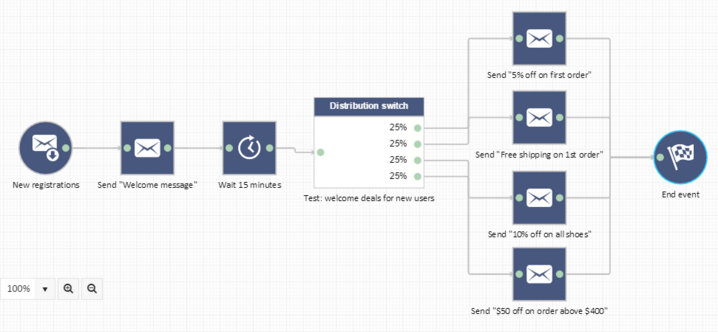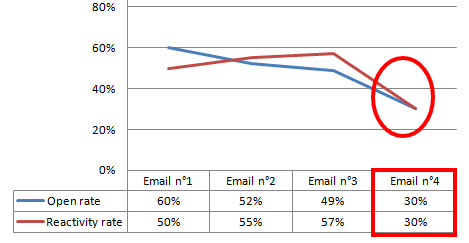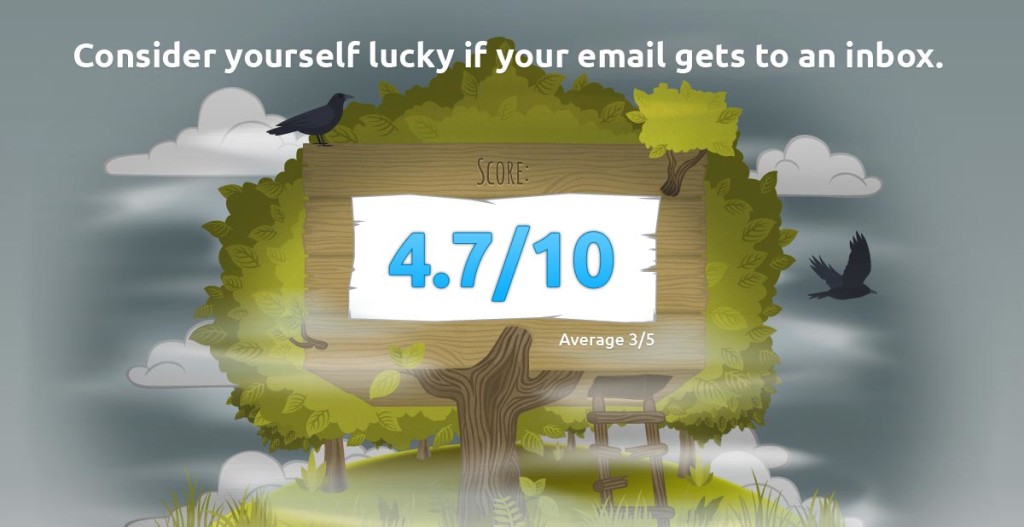Lead generation as a marketing technique is sometimes misunderstood, even by those who use it intensively! Focusing on collecting email addresses can overshadow the fact that lead generation is a global process in which collecting email addresses is just the beginning.
By nurturing your collected email addresses within 24 hours after the collect, you can expect an open rate that will be 4 times higher than if you send the same email after 2 months! It is important to keep in mind that lead nurturing represents half the value of your lead generation strategy, in order to maximize the potential of a lead generation strategy.
Not nurturing your leads affects the potential of your lead generation strategy
Not getting the attention you deserve
People receive a TON of email. On average receives 85 emails a day and in 2015 alone, Mailchimp sent more than 200 billion emails! That means that in order to have an impact, you need your emails to stand out. The easiest way to do so is to send email when your contact are expecting it. And in 2016, most people expect to receive a follow-up email right after they signed up to your service. Statistically speaking, a follow up email is the most efficient email you can send, provided that this email is sent right away :
- When a follow-up email is sent within 12 hours after the sign-in, the average open rate is around 60%, with a click/open rate ratio above 50%.
- The same email sent after 5 days has an average open rate of 20% and an click/open rate ratio of 30%
Reactivity is key! When you do not provide your contact with this strategic follow-up email, they might just forget about you. And this matters more than you may think.
Affecting your email delivrability
One of the key challenges of every email marketer is to make sure that its campaign have a high deliverability rate. Many factors can affect this deliverability, but the most important one is the sender’s history. When sending a follow-up email, you are essentially boosting your reputation by generating a lot of opens and clicks. Note that this follow-up email is also the only email that your new contacts are going to look for in their spam box.If you do not contact your leads right after they give you the permission to do so, you might be missing out on roughly 50% of them, that will neither never receive nor open your emails. Not nurturing your leads turns your lead generation program into a liability for all of your marketing strategy.
Easily set-up lead nurturing with email scenarios
Basic nurturing with a welcome email
Lead nurturing is crucial to your lead generation efficiency, but can be a pretty straightforward thing to set-up! A minimum set-up is to send a basic welcome email or offer a double opt-in.
A basic welcome email can be set-up with any autoresponder, and helps your new contact better understand what he signed up to. By explaining to your new contacts the frequency and the nature of what will be sent to their inbox, you can make sure that you are on the same page. This concordance between your offer and its expectations is the base of a healthy relationship from a marketing standpoint.
The welcome email is also a good way to increase the quality of your email base. Most people use a trash email adress to subscribe to the services they do not care about. By sending a welcome email, you can check if your sent emails are open or not, and use this information to decide if the new email address should be included in your lead lists. This welcome email should be your actual list inclusion parameter, rather than the sign up made by the visitor of your website.
A double opt-in refers to the action of sending an validation email on which a user has to click in order to subscribe to a service. It is also a good way to clean up the adresses that are collected as early as possible, by deleting the fake email addresses from your contact base. It is a really good process if you are a service that offers a customer account on which your contacts will find every information they need to know about your service. When it comes to lead generation, where you want to use emails as your primary dialogue source, double opt-in might not be the best option. Unlike welcome email, a double op-in process will not allow you to find out if the user used a secondary email address to subscribe to your service. Your “filters” will not be as strict, and your contact base not as qualitative.
Keep in mind that you need to focus on what actually matters. The quality of your contact base is your goodwill. The open and click rates you received on your welcome or validation email are secondary compared to the number and percentage of quality leads that you collected. It’s preferable to have a smaller list that will be highly reactive to your campaigns and marketing operations than a bigger one that includes a 1000 hard bounces.
From the welcome email to the onboarding scenario

A basic lead nurturing process will only take you so far, and you it is natural to reinforce your lead nurturing processes as your lead generation strategy matures. In order to have a more qualitative approach, you can onboard your new subscribers with not only one, but several welcome emails. This approach allows you to offer a more in-depth look at what your service is about, and really gets your new subscribers to commit to your service.
But an onboarding scenario is also a lot riskier. If not done right, you might lose the attention of your contacts, and get them to unsubscribe before having the opportunity to send them an actual campaign. The key is here to make sure each of your email provides more value added to your user than the previous one. Not an easy task! By doing so, each of your emails raises the level of expectations your new subscribers have when receiving your emails.
A great way to see if your onboarding program is successful is by monitoring your reactivity rate (click rate/open rate) across each one of your onboarding emails. If it is stable or increasing as your onboarding program goes on, you are doing fine. If it’s decreasing as your new subscribers progress in your onboarding program, you should keep working on it. I noticed that a natural bias is to give the best insights, articles, marketing incentives early one to try to hook up the new subscribers, and that the last step of onboarding programs are usually not as interesting.
Keep testing and measuring the performance of your onboarding programm to make sure that every step of it serves an actual purpose and is beneficiary to your new subscribers.

Here, the forth email of this onboarding scenario should be either updated or deleted.
With the development of automation marketing features within email marketing software such as MailChimp or Campaign Monitor, setting up a onboarding scenario is not a technical challenge anymore, but more of a marketing one. You need to find the right combination of content that will get your new subscribers hooked!
Tips for your onboarding scenario
- Do not assume that your value proposition is clear: it is a common rookie mistake to think that your new contact clearly understood what you are about. When people read your email, they might need to be reminded what makes you so special, so do it!.
- Focus on the value, not the feature: I call it the “product manager syndrom”. When you have worked hard on a new feature, a new product, etc, you tend to focus on how well thought this feature is, and lose sight of what problem it might actually solve for your potential customer. Always focus on the benefits of what you are offering.
- One idea at a time: Do not try to give too many informations at once to your users. During an onboarding process, it’s more efficient to send several emails to with only one Call to action than to confuse your new contacts with too many options within the same email. By focusing on one action at a time, you will be able to quickly identify the one your user value, by monitoring the click through rate of each of your onboarding emails.
Don’t wait and start nurturing your leads
We could go on and on about how to increase the performance of your onboarding program, by using behavioral datas and automation marketing, and to send different king of onboarding emails based on the customer engagement on past behaviour. That is not the point of this article.
The point we are trying to make is to that lead nurturing should not be seen as a different marketing operation than lead generation. They are actually two steps of the same marketing program and should be focusing on both at the same time. By nurturing your leads, your are enhancing the true value of your lead generation program.

Leave a Reply